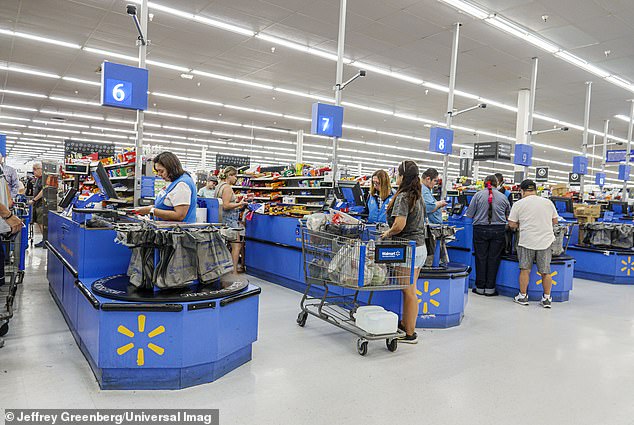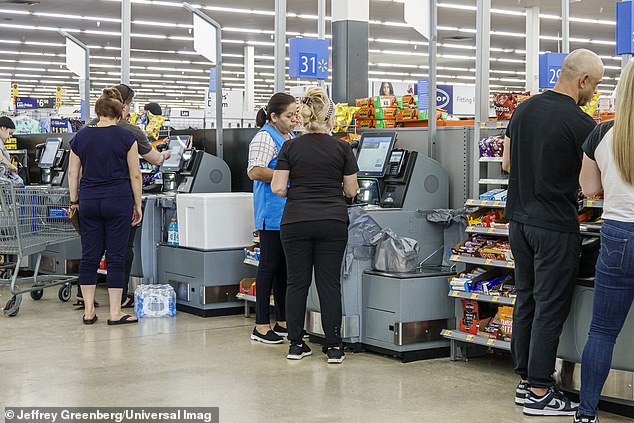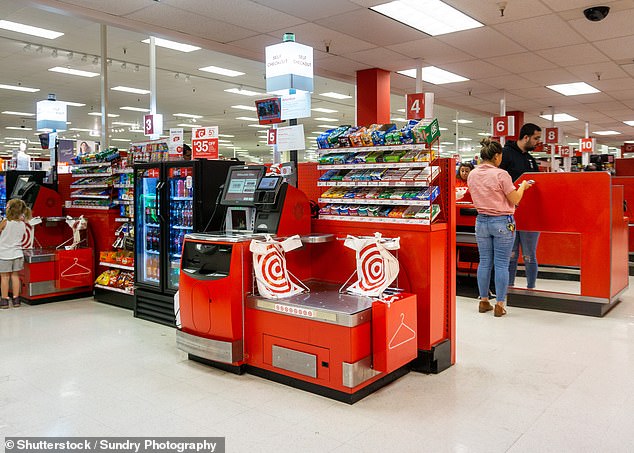Walmart removes self-checkouts and swaps back to ‘traditional’ lanes – but it’s not because they care about customer service
Walmart continues to remove self-checkout machines from its stores in an effort to improve the in-store experience for customers.
At two stores — in Shrewsbury, Missouri, and Cleveland, Ohio — the retailer said it would replace the kiosks with staffed checkouts that will “give our associates the opportunity to provide a more personalized and efficient service.”
In reality, many retailers are abandoning self-checkout kiosks because they are particularly vulnerable to shoplifting.
“The rollback of self-checkouts is largely due to retailers’ concerns about theft,” Neil Saunders, managing director of GlobalData, told DailyMail.com.
The turnaround of the world’s largest retailer could serve as a milestone in what appears to have been a years-long failed experiment.
Some of the largest retailers have taken steps this year to reverse the failed self-checkout experiment. The machines were designed to reduce labor costs, but caused increased theft

In two stores, in Missouri and Ohio, Walmart will completely replace self-checkout machines with “traditional” staffed lanes, as shown
Encouraging customers to scan and pay for items themselves was initially presented as a way to reduce queuing and improve efficiency, but was driven by retailers looking to reduce labor costs.
But it backfired. ‘Theft rates at self-checkouts are quite high, due to both intentional actions and unintentional errors. “Forcing more customers to use staffed checkouts will solve many of these problems and save retailers money,” Saunders said.
Not only that, many customers hated them. A study recently found that self-checkouts in stores make shoppers less loyal to certain stores.
Researchers at Drexel University in Pennsylvania found that the perceived ease of checkout and the feeling of having to do everything themselves irritated customers.
Walmart has not said whether it will continue to remove self-checkout machines from its more than 4,500 locations, but has made no announcement “at this time.”
“We have decided to remove the self-checkout lanes and replace them with staffed lanes in select locations,” a Walmart spokesperson told DailyMail.com.
“The decision was based on several factors, including employee and customer feedback, shopping patterns and business needs in the area.”
Self-checkout lanes are also more vulnerable to customer errors while scanning or weighing items.
Some products – such as fruit, meat and freshly baked goods – do not have barcodes and must be entered manually into the system. Customers may intentionally or accidentally enter a cheaper product code, leading to losses for the stores.
It comes after three stores in Albuquerque, New Mexico, did the same last year, the Albuquerque Journal reported at the time.

Self-checkout lanes are particularly vulnerable to theft because people are often trusted to pay for the correct items
And a slew of other retailers are taking similar steps, with Dollar General also removing the lanes altogether.
It was recently revealed that Target was limiting customers to 10 items when using self-checkouts.
And Missouri-based retailer Schnucks also said it would impose a 10-item limit on machines.

“The rollback of self-checkouts is largely due to retailers’ concerns about theft,” said Neil Saunders, managing director of GlobalData.
It was also recently reported that Target was introducing sensors to detect theft. The new system, called TruScan, uses cameras and sensors to detect items that shoppers cannot scan and will notify them with audio and visual cues.
But the secretive technology – known as TruScan – is different from simply having CCTV cameras pointed at the area that security staff are monitoring. Instead, computers powered by artificial intelligence are thought to be used to monitor shoppers as they scan items.
Target started rolling out the cameras several months ago and will equip all U.S. stores with them by the end of the year.
Last month, Dollar General announced it would completely remove self-checkout stands from 300 of its stores with the highest levels of shoplifting and improperly scanned items.
At 9,000 other locations, the company says it is converting some of its self-checkout registers to regular registers, and limiting self-checkout purchases to five items or fewer in another 4,500 stores.

Target is deploying new scanners to combat theft at its self-checkout counters, which will be rolled out across all stores by the end of the year
The company said the changes would help reduce shrinkage. This is retail jargon for product loss due to theft, damaged items and administrative errors.
“We believe these actions have the potential to have a material and positive impact on shrink,” Dollar General CEO Todd Vasos told analysts.
Kroger also added traditional checkout lanes to a Texas store where it previously only offered self-checkout machines, The Dallas Morning News reported.
Meanwhile, Costco started placing additional staff in self-checkout areas to monitor shoppers and ensure all items are scanned correctly, and to ensure membership cards are not shared.
